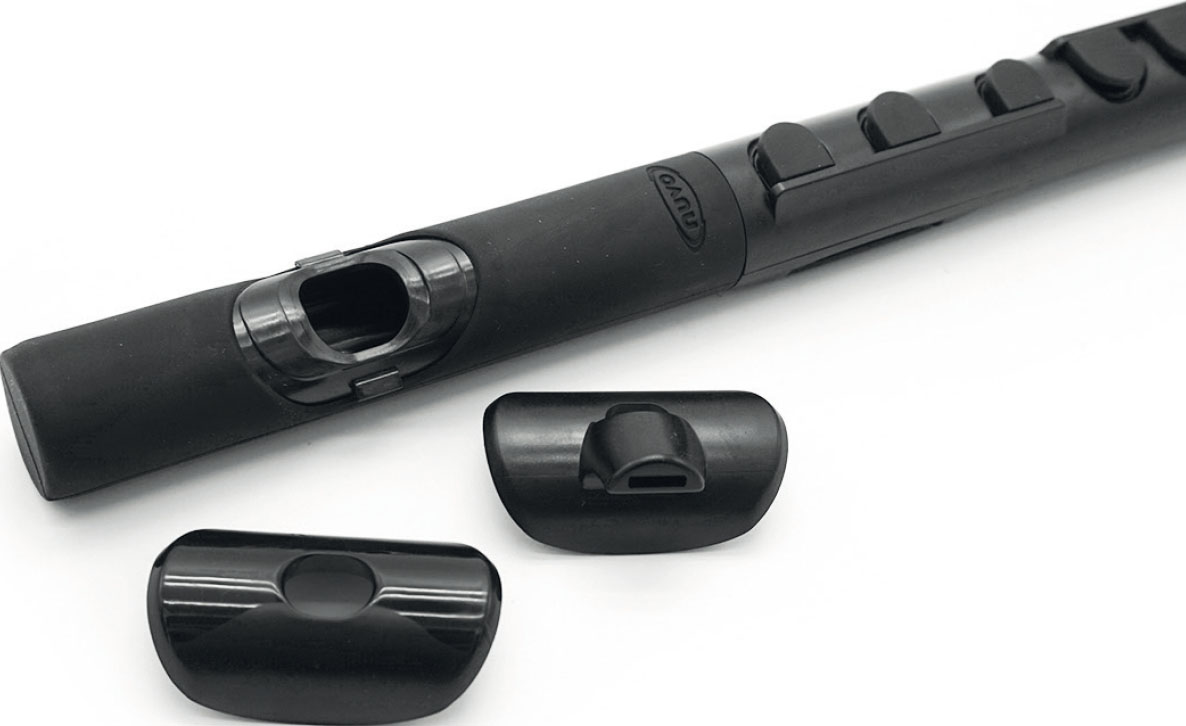
As a flautist who started out on the recorder, I have very vivid memories of being seven or eight and struggling to produce a note on the new shiny instrument I had just been handed. Or rather, a piece of an instrument – I was only allowed the headpiece of the flute until I could show that I could consistently produce a nice sound on it. Over time, the teacher added the other piece of the flute so that I could adjust to the weight and still make a nice note, which took several weeks. This is where the Toot comes in, to help bridge that gap and introduce useful skills from early on in someone's musical journey.
This is a very inexpensive instrument, retailing for around thirty pounds, and is ideally suited for anyone looking to progress from the recorder – not that you should neglect the recorder as it's a great instrument in its own right! As with the Dood, this is a lovely looking instrument. I had been sent the white and green one and, if I'm being honest, would buy a black instrument myself as I'd be forever worried about staining it. On that note, however, it's worth mentioning that both these instruments are waterproof and can be easily washed using warm soapy water – probably the one habit you can't carry over to a metal instrument!
Just like the Dood, it comes in a nice carry case and it was only once I'd seen both of them that I realised that the colours on the name badge correlate with the colour of the instrument inside – a nice way of knowing what you've got without having to open lots of bags. Inside is the instrument (equipped with the Firstnote lip plate), a fingering chart, and a normal lip plate along with a little key which is used to jimmy the plate off of the instrument. Do be careful when you are changing them – I didn't keep a hand on it and it pinged quite a way across the room and startled my colleague. I was a bit worried about breaking the thing but it's incredibly robust and therefore perfectly suited for younger players as they learn to take responsibility with their instrument.
I've spoken about the Firstnote lip plate before when I reviewed the Nuvo flute last year and while I wasn't impressed with it then, the way it works with the Toot seems much better. I'm not sure if the company has done something different with it or if it just works better with a smaller instrument, but the quality of the sound was wonderful and melodic. If you're unfamiliar, the Firstnote lip plate looks and functions like a recorder – you just need to blow into it to produce a note, without needing to really worry about embouchure.

The two mouthpieces are easily changeable
Regarding the other plate, the head joint of the instrument is removable and has little notches to show you where to line it up, with different positions indicated to help with noise production as the player familiarises themselves with what works for them. It plays really well, and you get a nice sound out of it quite easily. The fingering chart is quite easy to follow and does feel like a stepping-stone between the recorder and a flute with regards to positioning – though I did keep reflexively reaching out for keys which weren't there while doing some scales! The Toot can play an octave and half's worth of notes – more than enough to get anyone started and it provides plenty of song options to keep students entertained. It's possible to play D♯ and C♯ by removing two small plugs from the bottom keys. Be aware that these are very small, easily losable, and eminently swallowable so do keep an eye out for them during use. They are a nice feature and, together with the two distinct areas of the thumb key, add an extra layer of complexity that will put the student in good stead for advancement to flute.
I would definitely recommend this to primary music teachers looking to challenge their recorder groups and take them to the next level of their studies, as well as woodwind teachers who, like mine, might find that getting students to stick around and wait for the more fun stuff takes a bit too long. While discipline and perseverance are necessary qualities to achieve musical excellence, I do think that more students would stay involved with music if they were actually able to make music from an earlier point in time. Of my original class of eight recorder players, I ended up being the only one left playing flute as the others dropped out due to boredom and frustration. If only we had access to Toot at the time, how different things might have been!
View online here.




